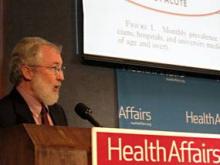WASHINGTON – More than a quarter (28%) of all acute care visits in the United States are made to the emergency department, while 20% of acute care visits are made to subspecialist offices, according to a study released Sept. 7.
Slightly less than half (42%) take place in primary care offices, said lead study author Dr. Stephen R. Pitts, who spoke at a briefing sponsored by the journal Health Affairs.
It appears that the more severe a complaint, the more likely a patient will seek care in the ED, said Dr. Pitts of the department of medicine at Emory University, Atlanta. However, the ED is frequently the only option for care, he said, noting that, "too often, patients can't get the care they need, when they need it."
Two-thirds of acute care ED occurred on weekends or on weekdays after office hours, Dr. Pitts and his colleagues found.
Uninsured patients received more than half their acute care in EDs, according to the study, which appears in the journal's September issue.
The authors based their study on data from the three federal surveys of ambulatory medical care in the outpatient, ED, and physician office setting.
Presenting complaints including stomach and abdominal pain, chest pain, and fever dominated the list of what brought patients to the ED. Conversely, patients who presented to their primary care physician’s office for acute care most frequently complained of cough, throat symptoms, rash, and earache.
Seventy-five percent of patients with acute respiratory problems received care in a primary care practice or hospital outpatient department, the authors found.
Overall, emergency physicians took care of 11% of all ambulatory care visits, yet make up only 4% of the physician workforce, the authors said.
Previous studies have shown that emergency care accounts for only 3% of all health spending, Dr. Arthur L. Kellermann, a study coauthor, said at the briefing.
"The fact that 3% of our dollars and 4% of our doctors are delivering that percentage of care is not such a bad deal," said Dr. Kellermann, an emergency physician and the Paul O'Neill Alcoa Chair in Policy Analysis at the Rand Corp. But, he said, it might not be the best possible care for patients or the optimum use of dollars for the health system.
In a separate study, Dr. Ateev Mehrotra and his colleagues reported that 14%-27% of ED visits could have been handled at either a retail clinic or an urgent care center. Switching to these alternate sites could save the system $4.4 billion a year, said Dr. Mehrotra of the University of Pittsburgh and a policy analyst at Rand.
The authors determined that most visits for nine common conditions treated at EDs could be switched easily to those alternate sites. Those conditions include upper-respiratory infections; musculoskeletal conditions such as strains, fractures, and back pain; dermatologic conditions; abdominal pain, headache, and other symptoms without a specific diagnosis; urinary tract infections, some chronic illnesses, and psychiatric conditions; lower-respiratory conditions; such minor problems as insect bites and conjunctivitis; and preventive care.
Dr. Mehrotra and his coauthors disclosed that they received funding from the California HealthCare Foundation for their study.
One of Dr. Pitts' coauthors disclosed that she received a training grant from the Centers for Disease Control and Prevention; others reported no conflicts


